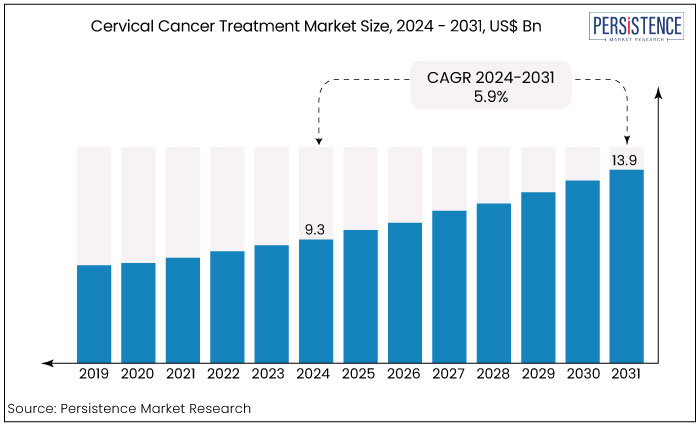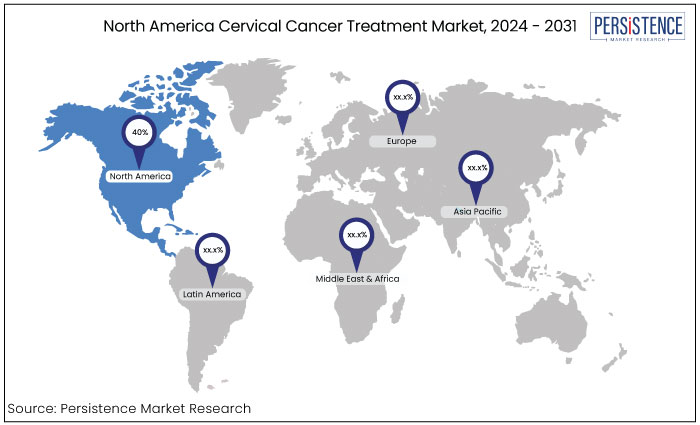Industry: Healthcare
Published Date: September-2024
Format: PPT*, PDF, EXCEL
Delivery Timelines: Contact Sales
Number of Pages: 169
Report ID: PMRREP34826
The cervical cancer treatment market is estimated to increase from US$9.3 Bn in 2024 to US$13.9 Bn by 2031. The market is projected to record a CAGR of 5.9% during the forecast period from 2024 to 2031. Increased adoption of immunotherapies like Keytruda, enhancing treatment outcomes leading the market forward during the forecast period. North America to dominate the market with significant market share in 2024.

Key Highlights of the Market
|
Market Attributes |
Key Insights |
|
Cervical Cancer Treatment Market Size (2024E) |
US$9.3 Bn |
|
Projected Market Value (2031F) |
US$13.9 Bn |
|
Global Market Growth Rate (CAGR 2024 to 2031) |
5.9% |
|
Historical Market Growth Rate (CAGR 2019 to 2023) |
4.8% |
|
Region |
Market Share in 2024 |
|
North America |
40% |
North America market is leading the global market capturing the most significant revenue share of 40% owing to the collaboration between governmental entities and healthcare organizations. These are aimed at augmenting awareness of cervical cancer therapy and improved payment policies to deliver superior services motivating individuals to seek treatment.
The U.S. cervical cancer treatment market led North America market capturing a substantial revenue share of 75%, attributed to the rising incidence of cervical cancer. This results in heightened governmental support for addressing the issue enhancing opportunities for corporate growth within the nation.
Technological improvements that have enhanced treatment techniques motivate patients to seek treatment greatly expanding the region's market. Canada is anticipated to expand at a CAGR of 11.3% during the forecast period. This expansion is propelled by increasing incidence rates, governmental funding, and technical advancements in treatment modalities.
Innovations in diagnostic technologies and therapeutic alternatives improve patient outcomes, while cooperative initiatives among healthcare providers and organizations facilitate better management and preventative tactics.

|
Category |
Market Share in 2024 |
|
Type - Squamous Cell Carcinoma |
72% |
The market for cervical cancer treatment is divided into squamous cell carcinoma, adenocarcinoma, and adenosquamous carcinoma based on type. Among these, the squamous cell carcinoma segment dominates the market.
The kind of carcinoma known as squamous cell carcinoma was the most prevalent in the market and accounted for the significant revenue share of 72%. The dominance of this segment can be related to chronic infection with high-risk human papillomavirus (HPV) subtypes particularly HPV 16 and 18, which are responsible for the majority of cases.
The burden is further compounded by the fact that low- and middle-income nations have restricted access to HPV vaccination, screening, and treatment. Furthermore, socioeconomic determinants such as poverty and gender biases contribute further to the inequities that exist in the prevention and control of cervical cancer.
|
Category |
Market Share in 2024 |
|
Treatment - Chemotherapy |
35% |
The market is divided into radiation therapy, chemotherapy, targeted therapy, and immunotherapy based on treatment. Among these, the chemotherapy treatment dominates the market. The process of chemotherapy treatment led the market and was responsible for the significant revenue share, which was 35%, owing to the breakthroughs in drug discovery.
The general treatment methods and accessibility have been improved as a result of increasing spending in healthcare organizations. Additionally, there is an increasing tendency toward individualized therapy techniques, which centre on therapeutic procedures specifically suited to individual needs of the patients.
Cervical cancer treatment encompasses medical measures designed to manage and eradicate cervical cancer. It is a malignancy originating in the cells of the cervix, the lower segment of the uterus. Treatment techniques for cervical cancer are contingent upon elements like the cancer stage, the patient's overall health, and the tumour's unique characteristics.
Cervical cancer is a considerable global health concern, with rising incidence rates in numerous areas. The World Health Organization (WHO) indicates that cervical cancer is the fourth most prevalent malignancy among women worldwide with around 660,000 new cases and 350,000 fatalities in 2022.
The high incidence and fatality rates of cervical cancer are found in low- and middle-income nations. This tendency stimulates the demand for productive treatment alternatives broadening the cervical cancer therapy market.
Governments and healthcare organizations worldwide are intensifying efforts to promote knowledge of diseases, especially cervical cancer and Human Papillomavirus (HPV) infections.
Awareness campaigns and screening programs are essential for early discovery and improving treatment outcomes. Government actions that bolster these programs and enhance access to treatment alternatives facilitate market expansion.
The cervical cancer treatment market has seen significant growth pre-2023 driven by increasing prevalence, awareness campaigns, and advancements in treatment options such as targeted therapies, immunotherapy, and advanced radiation techniques.
The introduction of HPV vaccines has helped reduce incidence rates but demand for treatment remains high due to late-stage diagnosis in many regions. Pre-2023, key factors fueled the market growth include improved healthcare infrastructure in emerging economies, and increased adoption of minimally invasive treatment options.
Post-2024, the cervical cancer treatment market is anticipated to expand at an accelerated pace, driven by technological advancements like personalized medicine, enhanced diagnostic tools, and next-generation sequencing.
The ongoing development of effective immunotherapies along with the emergence of new drug classes is expected to enhance patient outcomes and drive market demand. The increased investment in healthcare systems particularly in developing countries and expanded access to screening programs will boost market expansion.
Key players are expected to focus on partnerships and acquisitions to accelerate innovation and gain competitive advantages. The market is projected to expand at a CAGR with North America and Europe leading followed by significant growth in Asia Pacific.
Advancements in Immunotherapy and Targeted Therapies
One of the key drivers for growth in the cervical cancer treatment market is the development of advanced immunotherapies and targeted therapies. Traditional treatments like surgery, radiation, and chemotherapy have dominated the market. However, new approaches such as immune checkpoint inhibitors, monoclonal antibodies, and personalized medicine are transforming treatment landscapes. More precisely, these therapies target cancer cells sparing healthy tissue and minimizing side effects.
The introduction of drugs like pembrolizumab (Keytruda) for recurrent or metastatic cervical cancer has shown promising results in extending patient survival. Ongoing research into vaccine-based therapies such as therapeutic vaccines targeting the human papillomavirus (HPV) holds the potential to improve outcomes for cervical cancer patients. These innovations enhance treatment efficacy and attract greater investments from pharmaceutical companies.
As more clinical trials demonstrate positive outcomes, adopting immunotherapies and targeted treatments is expected to rise driving market growth significantly in both developed and emerging economies.
Increasing Prevalence and Awareness of Cervical Cancer
The increasing cases of cervical cancer particularly in low- and middle-income countries is a key factor driving the cervical cancer treatment market. According to the World Health Organization (WHO), cervical cancer is the fourth most common cancer among women worldwide with over 600,000 new cases and 340,000 deaths in 2020 alone.
In many developing countries, limited access to preventive measures like HPV vaccination and early screening programs has contributed to high incidence rates. However, increased awareness campaigns by governmental and non-governmental organizations are improving public understanding of the disease and encouraging early detection efforts.
Such initiatives are leading to an increasing number of diagnosed cases that require treatment. Efforts by global health bodies such as the WHO’s global strategy to eliminate cervical cancer are expected to reduce the burden of the disease through more widespread vaccination. As awareness and detection increase, the need for innovative cervical cancer treatments will continue to grow.
High Treatment Costs and Limited Access in Low-Income Regions
One of the key restraints for the growth of the cervical cancer treatment market is the high cost of advanced therapies such as immunotherapy and targeted treatments. The cutting-edge treatments while offering improved outcomes are often expensive making them inaccessible to a significant portion of the population.
In many regions, healthcare infrastructure needs to be developed, and access to specialized care is limited further hindering the adoption of these advanced treatments. Even when treatment options are available, the high out-of-pocket costs can deter patients from seeking timely care.
Also, the limited availability of healthcare insurance in many countries exacerbates the affordability issue. Such factors create a significant gap between the availability of advanced treatments and their accessibility slowing the overall growth of the treatment market especially in regions where the disease burden is highest.
Challenges in Early Diagnosis and Screening Implementation
There are persistent challenges in the early diagnosis of cervical cancer, particularly in low-resource settings despite advancements in diagnostic tools. Many women in developing countries lack access to regular screening programs such as Pap smears or HPV DNA testing, due to limited public awareness. This results in delayed diagnoses with many cases being identified at advanced stages where treatment is complex and less effective.
Even in developed regions adherence to regular screening protocols remains a challenge often due to insufficient health education or socioeconomic factors. The shortage of trained healthcare professionals and diagnostic equipment in rural areas contribute to inconsistent screening coverage.
Challenges in implementing widespread and effective screening programs hinder early detection, thereby impacting the timely initiation of treatment. As a result, this lack of early diagnosis limits the potential for the cervical cancer treatment market to fully expand.
Development of Personalized Medicine and Genomic Profiling
One of the most transformative opportunities in the cervical cancer treatment market lies in advancing personalized medicine mainly through genomic profiling. Personalized therapies tailored to the genetic makeup of individual tumours hold the potential to revolutionize cervical cancer treatment.
By using next-generation sequencing (NGS) and other molecular diagnostic tools, clinicians can identify specific genetic mutations or biomarkers that drive cancer progression in patients. It allows selection of targeted therapies such as small-molecule inhibitors or immunotherapies, most likely effective for a particular patient. These approaches can enhance treatment efficacy, minimize side effects, and improve patient outcomes.
As research in this field advances, personalized medicine has the potential to become the standard of care leading to precise and effective treatment strategies especially for patients with advanced or recurrent cervical cancer. This opportunity represents a significant shift in managing the disease positioning the market for growth through innovation.
The cervical cancer treatment market is highly competitive featuring prominent pharmaceutical companies and biotech firms focused on innovative therapies. Leading companies compete through clinical advancements, acquisitions, and partnerships to strengthen their portfolios. Emerging biotechs are also entering the market focusing on next-generation treatments like HPV-targeted vaccines and personalized medicine.
The market is characterized by intense research and development activity with an increasing focus on immunotherapy, targeted drugs, and advanced diagnostic tools. Regional players in developing markets further intensify competition especially in price-sensitive segments.
Recent Industry Developments in the Cervical Cancer Treatment Market
|
Attributes |
Details |
|
Forecast Period |
2024 to 2031 |
|
Historical Data Available for |
2019 to 2023 |
|
Market Analysis |
US$ Billion for Value |
|
Key Regions Covered |
|
|
Key Market Segments Covered |
|
|
Key Companies Profiled in the Report |
|
|
Report Coverage |
|
|
Customization & Pricing |
Available upon request |
By Type
By Treatment
By End Use
By Region
To know more about delivery timeline for this report Contact Sales

The market is estimated to be valued at US$13.9 Bn by 2031.
The market is projected to exhibit a CAGR of 5.9% over the forecast period.
Some of the leading players in the market are Novartis AG, AstraZeneca, GSK plc., and AbbVie Inc.
Advancements in immunotherapy and targeted therapies drives the market forward.
North America dominates the market for cervical cancer treatment.